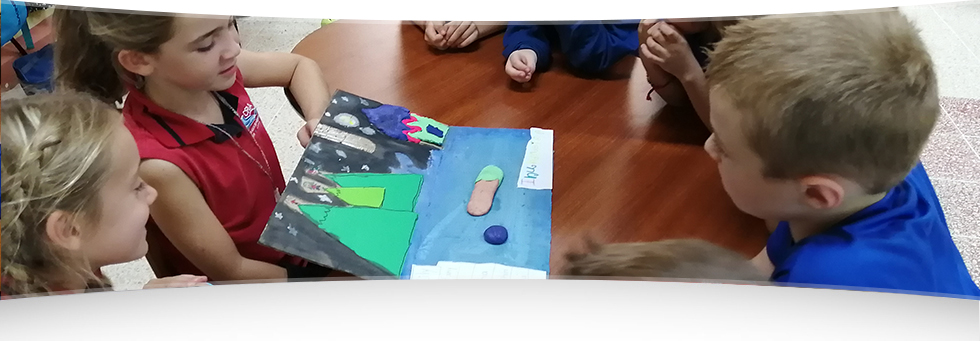CRIA Online — Learning Strategies
Effective online instruction depends on learning experiences appropriately designed and facilitated by the CRIA Online Teachers of Record. Multiple instructional strategies are used, and it is up to each individual teacher to provide online strategies that are aligned to CRIA standards and policies.*
Online Courses & Multiple Instructional Strategies
With student-centered instruction, online teachers take the role of facilitators of information and skills while guiding students toward new learning. Teachers as well as learners must take on new roles in the teaching-learning relationship.
Of the many instructional strategies available for use in the online learning environment, most have not been developed specifically for online instruction. CRIA teachers may choose some these strategies that accomplish particular educational objectives. From this perspective, instructional strategies are tools available to educators for designing and facilitating learning. Below are are some strategies that may be used for the CRIA Online (and Remote Learning) program:
Learning Contracts
Learning contracts connect educational needs to individual student needs. This bridge is useful when there is a diversity in learner needs and interests in a class. A learning contract is an agreement, written by the learner and/or the Learning Coach (LC), that details what will be learned, how the learning will be accomplished, the period of time involved, and the specific evaluation criteria to be used in judging the completion of the learning. Learning contracts help the educator, the learner and the LC share the responsibility for learning.
Contract learning can bring about many practical benefits, including deeper involvement of the learner and LC in the learning. Another benefit of utilizing contract learning is an increase of accountability, since the learning contract provides more functional and validated evidence of the learning outcomes. The contract also provides a means for the learner to receive continuous feedback regarding progress toward accomplishing learning objectives.
Learning contracts can be extremely effective in the online environment. Because physically meeting with the class to discuss learning goals, objectives, and expectations does not happen online, teachers must be very clear and concise in what they expect from the learner and the LC. Likewise, learners and LCs must also be clear about what they can expect from the teacher. A learning contract is a negotiated learning goals and outcomes document.
Video-Based Lessons
The video-based lesson is used daily through the Edgenuity platform. Less frequently a teacher will use a synchronous live stream, perhaps once a week, as an instructional method. Teachers know their students and develop their live sessions according to the students’ needs and to build a sense of community. Most importantly, all video sessions are most effective when used in combination with other instructional strategies.
Online videos for lessons should be shorter and more to the point than lectures in live classrooms which often extend far beyond the attention span of the students. Short video-based lessons provide enough information to serve as a basis for further reading, research, or other learning activities. Another obvious advantage of video-based lessons is that they are readily available for students to revisit as needed.
Discussion Board Forums (Upper Primary and Secondary)
Most of this generation of online students favor discussion as an instructional strategy because it is interactive and encourages participatory learning. Discussion encourages learners to analyze alternative ways of thinking and acting. Through this, learners explore their own experiences to become better critical thinkers. The discussion is often the heart of an online course; CRIA uses discussion board forums as an asynchronous communication tool as well.
Self-Directed Learning (Primary and Secondary)
Self-directed learning is individualized learning for self-instruction. Self-directed learning places the responsibility for learning directly on the learner. In many ways, practically all learning is ultimately self-directed. Learners who take the initiative and are proactive learners learn more and better than passive (reactive) learners do. Proactive learners are more purposeful. They also tend to retain and make use of what they learn better and longer than do reactive learners. The independent learner is one who is more involved, more motivated, and more active while learning.
CRIA Online learning supports the self-directed learner in pursuing individualized, self-paced learning activities. In Grades 1-10, the MAP diagnostic assessments provide an individualized roadmap for each student in numeracy and literacy. Another benefit is that the learner, working at a computer at a convenient time and pace, is able to search and utilize the vast resources of the Internet research nearly any topic imaginable. Students can visit libraries, museums and various institutes world-wide, talk to professionals, access recent research, and read newspapers and peer reviewed scholarly journals online. Students can write collaboratively with peers and even publish written and multimedia products on web pages.
Small Group Work
In small groups, learners discuss content, share ideas, and solve problems. They present ideas as well as consider ideas put forth by others. In this way, they see a variety of viewpoints on a subject. There are many small group formats that encourage and provide opportunities for interaction:
The Discussion Group
Allows learners to reflect on a subject under discussion and present their views. Discussion within the small group may vary from low, to very high levels of intellectual discourse.
Guided Design
Here the focus is on developing learners’ decision-making skills as well as on teaching specific concepts and principles. Participants work to solve open-ended problems which require outside class work to gather information. This format encourages learners to think logically, communicate ideas, and apply steps in a decision-making process. Learners must apply what they have learned, exchange ideas, and reflect on suggested solutions. The instructor’s role is to act as a consultant to the groups.
Role Playing/Simulation
Recreate a situation relating to a real-world problem in which participants act out various roles. This promotes understanding other people’s positions and attitudes, as well as the procedures useful for diagnosing and solving problems. Role playing can be used to simulate real-life group work situations and can help learners gain an understanding of a problem or situation.
Games
Two or more groups compete to meet a set of objectives. The game follows rules and procedures. The instructor provides Information that requires decision-making. Most instructional games reflect typical real-life situations. The rules, procedures, and objectives of the game must be clear and concise.
Online learning environments offer several distinct benefits for small group work. First, they allow small groups to work independently while still having access to the instructor. In some cases where it is difficult for all members of an online class to meet synchronously, small groups can be organized according to their time zones, making it possible to find a convenient time to meet synchronously. Larger groups can benefit by communicating asynchronously via conferencing programs. Finally, the instructor is able to respond directly to questions and needs of particular groups without taking the time of other groups.
Project-Based Learning
Online projects give students opportunities to pursue special interests individually or within groups. Projects also provide students with practical experience and a sense of accomplishment. Using projects in a learning activity makes the learning more relevant to the learners. Products can be shared with others in the class and critiqued or by the facilitator alone. By sharing individual projects with other participants, the learner obtains more diverse viewpoints and feedback.
Many of the instructional strategies discussed on this page can be considered group projects. Group projects can include simulations, role playing, case studies, problem solving exercises, group collaborative work, debates, small group discussion, and brainstorming. As with individual projects, projects for participants in groups should receive peer feedback to expose them to diverse viewpoints. With independent and group projects learners pursue special interests, write or create for an audience, and publish or present their findings and conclusions via the Internet.
Collaborative Learning
Collaborative learning is the process of getting two or more students to work together to learn. Compose small groups’ participants of differing ability levels and use a variety of learning activities to master material initially developed by an instructor, or construct knowledge on substantive issues. Each member of the team is responsible for learning what is taught and for helping teammates learn.
Collaborative learning can be more effective than interpersonal competitive and individualistic efforts in promoting cognitive development, self-esteem, and positive student-student relationships.
Case Study (Secondary)
The case study requires learners to draw upon their experience, is participatory, and has action components that are links to future experience. The key to a successful case study is the selection of an appropriate problem situation which is relevant both to the interests and experience level of learners and to the concepts being taught. The case report should include facts regarding the problem, the environmental context, and the characters of the people involved in the case. It should be factual, but also contain the opinions and views of the people involved. Learners should have access to the problem solution, but not until they have reached their own conclusions and can then compare their results with the actual decision taken to resolve the problem.
Learners, in a case study, can work independently or in groups. One advantage of using the case method is that it emphasizes practical thinking and assists learners in identifying principles after examining the facts of the case, then applying those principles to new situations. Case analysis is equally effective when used in combination with other instructional strategies.
In the online environment, present case studies on web pages and discuss in conferencing groups. Cases can be developed by class groups as collaborative projects. In addition, tap the vast resources of the Internet to contribute data, information, and expert advice to case development and analysis.
Forum (Secondary)
The forum is an open discussion between one or more resource people and a group. A moderator guides the discussion and the audience raises and discusses issues, make comments, offers information, or asks questions of the resource person(s) and each other.
The Panel Discussion (Secondary)
Usually three to six people who sit before an audience and have a purposeful conversation on a topic in which they have specialized knowledge. Guided by a moderator, the panel is informal in nature, but allows for no audience participation.










